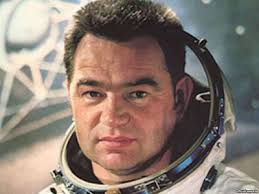Georgy Grechko
Russian - (RFSA)
Deceased
Date of Birth: May 25, 1931
Date of Death: April 8, 2017
Georgy Mikhaylovich Grechko (Russian: Георгий Михайлович Гречко; 25 May 1931 – 8 April 2017) was a Soviet cosmonaut who flew on several space flights including Soyuz 17, Soyuz 26, and Soyuz T-14.
Soyuz | Soyuz 17
Russian Federal Space Agency (ROSCOSMOS) | RussiaBaikonur Cosmodrome, Republic of Kazakhstan
Jan. 10, 1975, 9:43 p.m.
Status: Success
Mission:
Soyuz 17 was the first of two long-duration missions to the Salyut-4 space station. The mission began on January 10, 1975, 21:43:37 UTC, launching commander Aleksei Gubarev and flight engineer Georgi Grechko into orbit. Spacecraft was manually docked with the station on January 12. During their stay on the station, crew performed an array of astrophysical experiments, including studying the Sun, planets and the stars in a wide electromagnetic spectrum. The mission concluded after 29 days with a safe landing back on Earth on February 9, 1975, 11:03:22 UTC.
Low Earth OrbitSoyuz-U | Soyuz 26
Russian Federal Space Agency (ROSCOSMOS) | RussiaBaikonur Cosmodrome, Republic of Kazakhstan
Dec. 10, 1977, 1:18 a.m.
Status: Success
Mission:
Soyuz 26 carried Salyut 6 EO-1, which was the first long-duration expedition to the Salyut 6 space station. The mission began on December 10, 1977, 01:18:40 UTC, launching Commander Yuri Romanenko and Flight Engineer Georgi Grechko into orbit. They docked with the station the next day. During their 96-day stay in orbit, crew performed the first Soviet spacewalk since 1969 with the purpose of inspecting one of the stations docking ports. They also performed Earth observation, carried out various experiments and tested new navigation system. EO-1 crew was visited by Soyuz 27 and Soyuz 28 crews; the first ever refueling of the station was performed by an uncrewed cargo ship Progress 1 during the mission. EO-1 crew swapped vehicles with the Soyuz 27 crew, which allowed for a longer stay in orbit. EO-1 crew returned in the Soyuz 27 spacecraft, landing safely back on Earth on March 16, 1978, 11:18:47 UTC.
Low Earth OrbitSoyuz-U | Soyuz 27
Russian Federal Space Agency (ROSCOSMOS) | RussiaBaikonur Cosmodrome, Republic of Kazakhstan
Jan. 10, 1978, 12:26 p.m.
Status: Success
Mission:
Soyuz 27 carried Salyut 6 EP-1 mission to the Salyut 6 space station. The mission began on January 10, 1978, 12:26:00 UTC, launching Commander Vladimir Dzhanibekov and Flight Engineer Oleg Makarov into orbit. They docked with the station the next day. During their 5-day stay on the station, crew performed various scientific and technological experiments. EP-1 crew swapped vehicles with the Soyuz 26 (EO-1 expedition) crew, which allowed for a longer stay in orbit for EO-1. EP-1 crew returned in the Soyuz 26 spacecraft, landing safely back on Earth on January 16, 1978, 11:24:58 UTC.
Low Earth OrbitSoyuz-U2 | Soyuz T-13
Soviet Space Program | RussiaBaikonur Cosmodrome, Republic of Kazakhstan
June 6, 1985, 6:39 a.m.
Status: Success
Mission:
Soyuz T-13 was the eighth mission to visit the Salyut 7 space station. The mission began on June 6, 1985, 06:39:52 UTC, launching Commander Vladimir Dzhanibekov and Flight Engineer Viktor Savinykh into orbit. Following a two day solo flight Soyuz T-13 docked with Salyut 7 on June 08. When arriving there, the station had been vacant since eight month and it had been crippled by a solar array problem. Soyuz T-13 was the first Soyuz to dock manually with an inert Salyut. During their stay on the station, crew had to perform numerous repairs to restore life support, power and other systems, and conducted two EVAs for the same reasons. Cosmonauts were visited by a Progress cargo spacecraft and a Soyuz T-14, who joined the work on the station. Vladimir Dzhanibekov returned to Earth with the Soyuz T-14 crew member, while Viktor Savinykh stayed to continue his work on the station. The mission concluded with a safe landing back on Earth on September 26, 1985, 09:51:58 UTC.
Low Earth OrbitSoyuz-U2 | Soyuz T-14
Soviet Space Program | RussiaBaikonur Cosmodrome, Republic of Kazakhstan
Sept. 17, 1985, 12:38 p.m.
Status: Success
Mission:
Soyuz T-14 was the ninth mission to visit the Salyut 7 space station. The mission began on September 17, 1985, 12:38:52 UTC, launching Commander Vladimir Vasyutin, Flight Engineer Georgi Grechko and Research Cosmonaut Alexander Volkov into orbit. They docked with the station next day. During their stay on the station, cosmonauts assisted resident Soyuz T-13 crew with numerous repairs on the station. They also conducted some scientific experiments. Georgi Grechko returned to Earth early with the Soyuz T-13 crew member. The mission concluded with a safe landing back on Earth on November 21, 1985, 10:31:00 UTC.
Low Earth OrbitThe Roscosmos State Corporation for Space Activities, commonly known as Roscosmos, is the governmental body responsible for the space science program of the Russian Federation and general aerospace research. Soyuz has many launch locations the Russian sites are Baikonur, Plesetsk and Vostochny however Ariane also purchases the vehicle and launches it from French Guiana.
Long March 7
Tianzhou-9
201 - Wenchang Space Launch Site, People's Republic of ChinaEighth cargo delivery mission to the Chinese space station.
Falcon 9
Dror-1
Space Launch Complex 40 - Cape Canaveral SFS, FL, USANote: SpaceX identifies the mission as "Commercial GTO 1". Dror-1 is a geostationary communication satellite built and developed by Israel Aerospa…
Falcon 9
Starlink Group 10-28
Space Launch Complex 40 - Cape Canaveral SFS, FL, USAA batch of 28 satellites for the Starlink mega-constellation - SpaceX's project for space-based Internet communication system.
Soyuz 2.1a
Progress MS-31 (92P)
31/6 - Baikonur Cosmodrome, Republic of KazakhstanProgress resupply mission to the International Space Station.
Long March 4C
Shiyan 28 B-01
Launch Complex 3 (LC-3/LA-1) - Xichang Satellite Launch Center, People's Republic of ChinaSatellite officially named for "space environment detection" purposes, exact details unknown.




